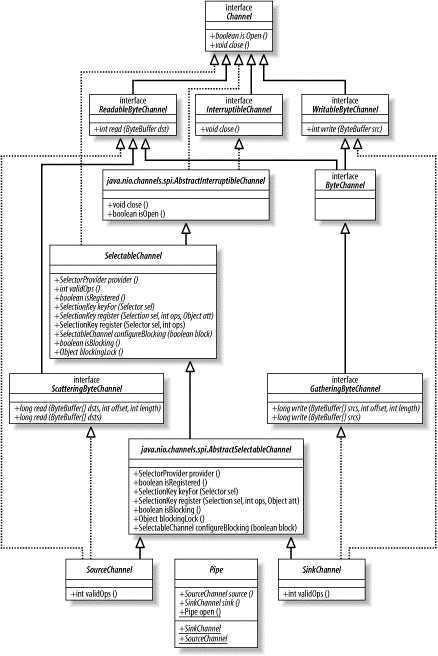标签:
java.nio.channels包中含有一个名为Pipe(管道)的类。广义上讲,管道就是一个用来在两个实体之间单向传输数据的导管。管道的概念对于Unix(和类Unix)操作系统的用户来说早就很熟悉了。Unix系统中,管道被用来连接一个进程的输出和另一个进程的输入。Pipe类实现一个管道范例,不过它所创建的管道是进程内(在Java虚拟机进程内部)而非进程间使用的。
参见图3-10。

/* * @(#)Pipe.java 1.21 05/11/17 * * Copyright 2006 Sun Microsystems, Inc. All rights reserved. * SUN PROPRIETARY/CONFIDENTIAL. Use is subject to license terms. */ package java.nio.channels; import java.io.IOException; import java.nio.channels.spi.*; /** * A pair of channels that implements a unidirectional pipe. * * <p> A pipe consists of a pair of channels: A writable {@link * Pipe.SinkChannel </code>sink<code>} channel and a readable {@link * Pipe.SourceChannel </code>source<code>} channel. Once some bytes are * written to the sink channel they can be read from source channel in exactly * the order in which they were written. * * <p> Whether or not a thread writing bytes to a pipe will block until another * thread reads those bytes, or some previously-written bytes, from the pipe is * system-dependent and therefore unspecified. Many pipe implementations will * buffer up to a certain number of bytes between the sink and source channels, * but such buffering should not be assumed. </p> * * * @author Mark Reinhold * @author JSR-51 Expert Group * @version 1.21, 05/11/17 * @since 1.4 */ public abstract class Pipe { /** * A channel representing the readable end of a {@link Pipe}. </p> * * @since 1.4 */ public static abstract class SourceChannel extends AbstractSelectableChannel implements ReadableByteChannel, ScatteringByteChannel { /** * Constructs a new instance of this class. */ protected SourceChannel(SelectorProvider provider) { super(provider); } /** * Returns an operation set identifying this channel‘s supported * operations. * * <p> Pipe-source channels only support reading, so this method * returns {@link SelectionKey#OP_READ}. </p> * * @return The valid-operation set */ public final int validOps() { return SelectionKey.OP_READ; } } /** * A channel representing the writable end of a {@link Pipe}. </p> * * @since 1.4 */ public static abstract class SinkChannel extends AbstractSelectableChannel implements WritableByteChannel, GatheringByteChannel { /** * Initializes a new instance of this class. */ protected SinkChannel(SelectorProvider provider) { super(provider); } /** * Returns an operation set identifying this channel‘s supported * operations. * * <p> Pipe-sink channels only support writing, so this method returns * {@link SelectionKey#OP_WRITE}. </p> * * @return The valid-operation set */ public final int validOps() { return SelectionKey.OP_WRITE; } } /** * Initializes a new instance of this class. */ protected Pipe() { } /** * Returns this pipe‘s source channel. </p> * * @return This pipe‘s source channel */ public abstract SourceChannel source(); /** * Returns this pipe‘s sink channel. </p> * * @return This pipe‘s sink channel */ public abstract SinkChannel sink(); /** * Opens a pipe. * * <p> The new pipe is created by invoking the {@link * java.nio.channels.spi.SelectorProvider#openPipe openPipe} method of the * system-wide default {@link java.nio.channels.spi.SelectorProvider} * object. </p> * * @return A new pipe * * @throws IOException * If an I/O error occurs */ public static Pipe open() throws IOException { return SelectorProvider.provider().openPipe(); } }

Pipe实例是通过调用不带参数的Pipe.open( )工厂方法来创建的。Pipe类定义了两个嵌套的通道类来实现管路。这两个类是Pipe.SourceChannel(管道负责读的一端)和Pipe.SinkChannel(管道负责写的一端)。这两个通道实例是在Pipe对象创建的同时被创建的,可以通过在Pipe对象上分别调用source( )和sink( )方法来取回。
此时,您可能在想管道到底有什么作用。您不能使用Pipe在操作系统级的进程间建立一个类Unix管道(您可以使用SocketChannel来建立)。Pipe的source通道和sink通道提供类似java.io.PipedInputStream和java.io.PipedOutputStream所提供的功能,不过它们可以执行全部的通道语义。请注意,SinkChannel和SourceChannel都继承了AbstractSelectableChannel(所以也间接地继承了SelectableChannel),这意味着pipe通道可以同选择器一起使用 。
管道可以被用来仅在同一个Java虚拟机内部传输数据。虽然有更加有效率的方式来在线程之间传输数据,但是使用管道的好处在于封装性。生产者线程和用户线程都能被写道通用的Channel API中。根据给定的通道类型,相同的代码可以被用来写数据到一个文件、socket或管道。选择器可以被用来检查管道上的数据可用性,如同在socket通道上使用那样地简单。这样就可以允许单个用户线程使用一个Selector来从多个通道有效地收集数据,并可任意结合网络连接或本地工作线程使用。因此,这些对于可伸缩性、冗余度以及可复用性来说无疑都是意义重大的。
Pipes的另一个有用之处是可以用来辅助测试。一个单元测试框架可以将某个待测试的类连接到管道的“写”端并检查管道的“读”端出来的数据。它也可以将被测试的类置于通道的“读”端并将受控的测试数据写进其中。两种场景对于回归测试都是很有帮助的。
管路所能承载的数据量是依赖实现的(implementation-dependent)。唯一可保证的是写到SinkChannel中的字节都能按照同样的顺序在SourceChannel上重现。
例3-11诠释了如何使用管道。
/** * */ package test.nio.pipe; import java.nio.ByteBuffer; import java.nio.channels.Channels; import java.nio.channels.Pipe; import java.nio.channels.ReadableByteChannel; import java.nio.channels.WritableByteChannel; import java.util.Random; /** * * Test Pipe objects using a worker thread. ** Created April, 2002 * @author * Ron Hitchens (ron@ronsoft.com) */ public class PipeTest { public static void main(String[] argv) throws Exception { // Wrap a channel around stdout WritableByteChannel out = Channels.newChannel(System.out); // Start worker and get read end of channel ReadableByteChannel workerChannel = startWorker(10); ByteBuffer buffer = ByteBuffer.allocate(100); while (workerChannel.read(buffer) >= 0) { buffer.flip(); out.write(buffer); buffer.clear(); } } // This method could return a SocketChannel or // FileChannel instance just as easily private static ReadableByteChannel startWorker(int reps) throws Exception { Pipe pipe = Pipe.open(); Worker worker = new Worker(pipe.sink(), reps); worker.start(); return (pipe.source()); }// ----------------------------------------------------------------- /** * * A worker thread object which writes data down a channel. * Note: this * object knows nothing about Pipe, uses only a * generic * WritableByteChannel. */ private static class Worker extends Thread { WritableByteChannel channel; private int reps; Worker(WritableByteChannel channel, int reps) { this.channel = channel; this.reps = reps; } // Thread execution begins here public void run() { ByteBuffer buffer = ByteBuffer.allocate(100); try { for (int i = 0; i < this.reps; i++) { doSomeWork(buffer); // channel may not take it all at once while (channel.write(buffer) > 0) { // empty } } this.channel.close(); } catch (Exception e) { // easy way out; this is demo code e.printStackTrace(); } } private String[] products = { "No good deed goes unpunished", "To be, or what?", "No matter where you go, there you are", "Just say \"Yo\"", "My karma ran over my dogma" }; private Random rand = new Random(); private void doSomeWork(ByteBuffer buffer) { int product = rand.nextInt(products.length); buffer.clear(); buffer.put(products[product].getBytes()); buffer.put("\r\n".getBytes()); buffer.flip(); } } }
例3-11 工作线程对一个管道进行写操作
以上内容出自 : NIO 一书
标签:
原文地址:http://www.cnblogs.com/mjorcen/p/4199583.html